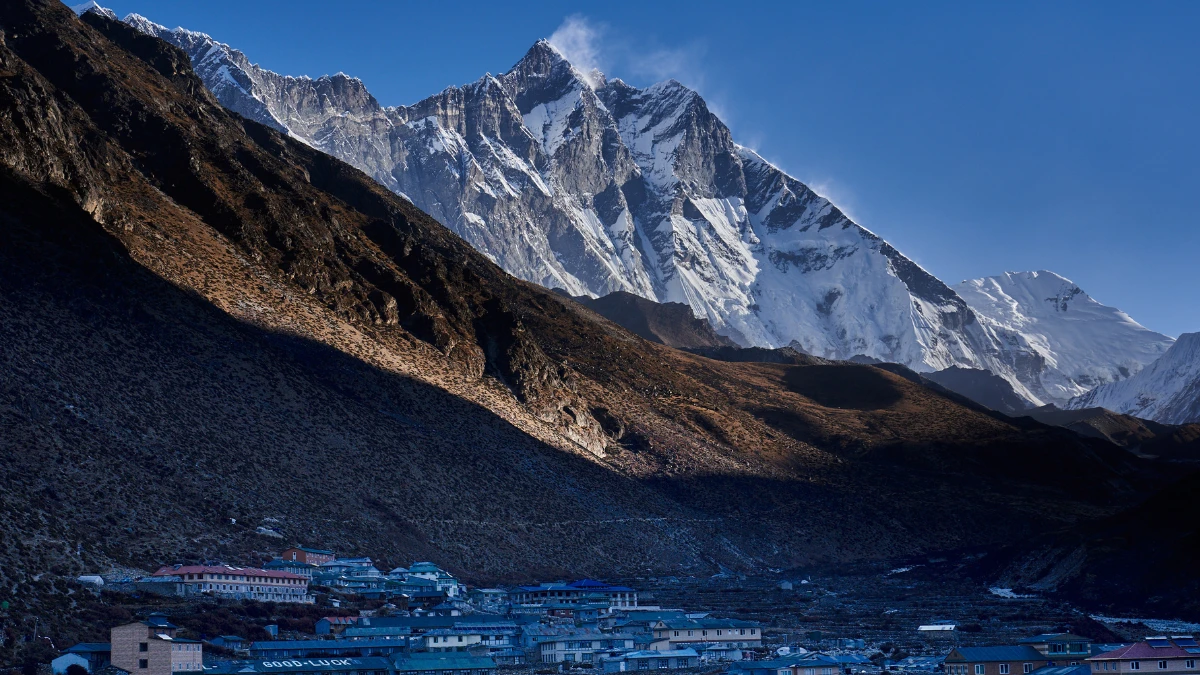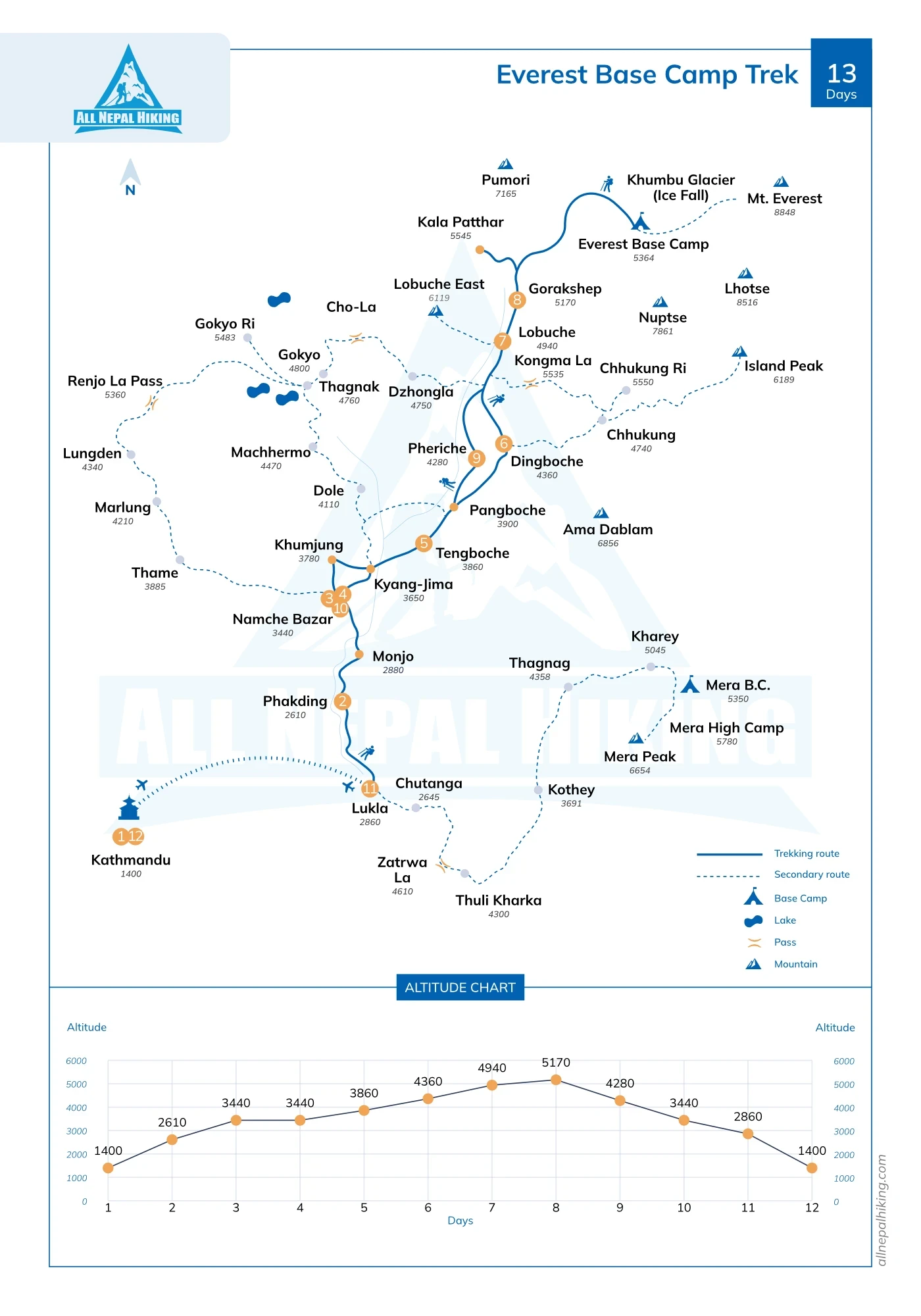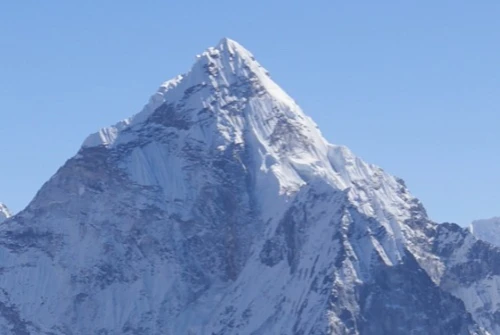Overview
The 13 days Everest Base Camp Trek is one of the most iconic adventures in the world, drawing travelers from across the globe to witness the majesty of Mount Everest up close. While many trek itineraries vary in services and inclusions, the Bed and Breakfast (B&B) model offers an attractive balance between structure and freedom. In this 13-day adventure, you’ll have your teahouse accommodations and breakfasts arranged in advance, while you remain free to choose your lunches and dinners along the way. This not only makes the trip more budget-friendly but also allows you to enjoy flexibility in your food preferences each day.
Unlike fully packaged treks, where every meal is set, the B&B trek ensures you always have a comfortable bed and a nourishing breakfast to start your morning, leaving the rest of the meals and extras up to your choice. From warm dal bhat and momos to international dishes like pasta or pancakes, you can experiment with the diverse menus in the teahouses while managing your budget at the same time.
Over 13 days, this journey takes you from the thrilling flight into Lukla to the bustling Namche Bazaar, the spiritual heart at Tengboche Monastery, the high-altitude villages of Dingboche and Lobuche, and finally to Everest Base Camp itself, standing at 5,364 meters. The trek also includes a climb to Kala Patthar, the best viewpoint for witnessing the sunrise or sunset over Mount Everest. Carefully designed with acclimatization stops, this plan ensures safety and comfort while keeping the trip efficient.
By choosing the Bed and Breakfast style, you embrace both reliability and freedom. You don’t have to worry about accommodation availability, yet you still enjoy the freedom to make daily choices about food, timing, and spending. It’s a perfect option for both first-time trekkers and experienced adventurers who want to savor the EBC experience in their own way.
Trip Highlights
Bucket-list milestones: Everest Base Camp (5,364 m) and Kala Patthar for sunrise or sunset views of Everest, Nuptse, and Pumori.
Sherpa culture: Namche Bazaar’s lively market, Tengboche Monastery chants, Mani walls, and prayer flags that color the wind.
Iconic trail moments: Suspension bridges over the Dudh Koshi, rhododendron forests, and the lunar landscapes above Dingboche and Lobuche.
Satisfying flexibility: Order exactly what you crave, from dal bhat power 24-hour to apple pie, and keep your budget balanced.
Why Choose a Bed and Breakfast Package for Everest Base Camp?
The main appeal of a bed and breakfast package lies in its balance between affordability and freedom. Many trekkers prefer this plan because it reduces costs significantly while still offering a structured journey. With breakfasts included, trekkers start their day energized, but they also have the flexibility to decide where and what to eat for lunch and dinner.
This freedom enhances the cultural experience. Every village along the trail has its own flavors and specialties. In Namche Bazaar, you might try Sherpa stew; in Dingboche, yak cheese pizza; and in Gorak Shep, simple noodles to keep warm in the thin air. Rather than being tied to a fixed meal plan, you get to discover these delights at your own pace.
Another advantage is the sense of independence. While guided, the trek doesn’t feel overly restricted; you’re given structure but also room to personalize your journey. For travelers who want value without sacrificing quality, the bed and breakfast plan strikes the perfect middle ground.
What “Bed & Breakfast” Means on the EBC Trail
Choosing a Bed & Breakfast (B&B) plan for the Everest Base Camp (EBC) trek provides comfort where it matters: a clean teahouse bed each night and a hearty breakfast every morning, while leaving lunches and dinners flexible and pay-as-you-go. It’s the sweet spot between full-board packages and going completely independent.
Teahouse concept explained
Along the Khumbu trail, family-run teahouses line each village. Think of them as cozy mountain inns: simple rooms, shared dining halls warmed by a yak-dung stove, and menus serving everything from dal bhat to pasta and pancakes. On a B&B plan, your accommodation is reserved and breakfast is included; you pay for other meals yourself, choosing what and when you eat.
What’s included vs. pay-as-you-go
Included: pre-booked rooms, breakfast each trekking day, and often the logistics (guide, porter, permits) depending on how you arrange it. Pay-as-you-go: lunches, dinners, drinks, snacks, hot showers, battery charging, Wi-Fi cards, and personal items. This structure keeps costs transparent and lets you customize your diet and spending in real time.
Who This 13-Day B&B Everest Trek Itinerary Is For
If you like freedom with a safety net, this format is yours. You don’t have to worry about where you’ll sleep or early-morning fueling, yet you can experiment with menus and adjust your calories as you feel the altitude.
First-time trekkers
New to the Himalaya? The B&B trek keeps logistics streamlined: rooms are arranged, daily starts are clear, and there’s a set rhythm to mornings. Meanwhile, you’ll learn the teahouse system without the pressure of managing everything alone.
Budget-conscious adventurers
Costs add up on EBC, especially for food at higher altitudes. With B&B, you see exactly where your money goes. Pick lighter lunches or split pizzas, sip endless ginger lemon honey, or go big on yak steak after a hard day; you’re in control.
Verdict
The Everest Base Camp Trek Bed & Breakfast balances structure and freedom better than any other format. Your bed is guaranteed, breakfast is waiting, and the rest is up to you, whether that’s an extra bowl of thukpa in Dingboche, a longer espresso stop in Namche, or a celebratory apple pie in Lukla. With smart acclimatization, a steady pace, and the flexibility to eat what you love, you’re set for a safe, budget-savvy, and deeply satisfying journey to the foot of the world’s highest mountain. Lace up, sip that morning tea, and let’s walk into the thin air, together.
13-Day Route Overview at a Glance
You’ll fly Kathmandu/Ramechhap to Lukla, trek into the Khumbu heartland, acclimatize in Namche and Dingboche, tag EBC and Kala Patthar, then return to Lukla for your flight out. The 13-day design blends proper acclimatization with efficiency—no frantic rushing, no excessive downtime.
Elevation profile
Lukla (2,860 m) → Namche (3,440 m) → Tengboche (3,860 m) → Dingboche (4,410 m) → Lobuche (4,940 m) → Gorak Shep (5,164 m) → EBC (5,364 m) → Kala Patthar (≈5,545 m). We ascend gradually, building red-blood-cell confidence.
Key acclimatization days
Two classic “climb high, sleep low” days—Namche and Dingboche—anchor the plan. They reduce AMS risk and set you up for a strong summit of Kala Patthar.



 based on 9 reviews
based on 9 reviews
